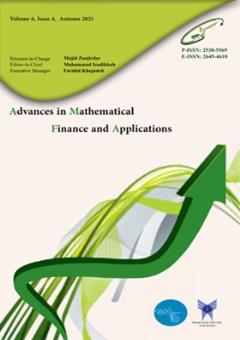Designing a Trading Strategy to Buy and Sell the Stock of Companies Listed on the New York Stock Exchange Based on Classification Learning Algorithms
Subject Areas : Financial Engineering
Nasser Heydari
1
,
Majid Zanjirdar
2
![]() ,
Ali Lalbar
3
,
Ali Lalbar
3
1 - Islamic Azad University, Arak, Iran
2 - Departman of Finance, Islamic Azad University ,Arak, Iran
3 - Department of Accounting, Arak Branch, Islamic Azad University, Arak, Iran
Keywords: Trading Strategy , Machine Learning, Classification Algorithms,
Abstract :
This research investigated the development of a stock trading strategy for companies on the New York Stock Exchange (NYSE), a prominent global market. Data was acquired from established libraries and the Yahoo Finance database. The model employed technical analysis indicators and oscillators as input features. Machine learning classification algorithms were used to design trading strategies, and the optimal model was identified based on statistical performance metrics. Accuracy, recall, and F-measure were utilized to evaluate the classification algorithms. Additionally, advanced statistical methods and various software tools were implemented, including Python, Spyder, SPSS, and Excel. The Kruskal-Wallis test was employed to assess the statistical differences between the designed strategies. A sample of 41 actively traded NYSE companies across diverse sectors such as financial services, healthcare, technology, communication services, consumer cyclicals, consumer staples, and energy were chosen using a filter-based approach on June 28th, 2021. The selection criteria included a market capitalization exceeding $200 billion and an average daily trading volume surpassing 1 million shares. Evaluation metrics revealed that the designed random forest trading strategy achieved a good fit with the data and exhibited statistically significant differences from other strategies based on classification learning algorithm.
[1] Cortes, C., Vapnik, V., Support-Vector Networks, Machine Learning, 1995; 20:273–297. Doi: 10.1007/BF00994018.
[2] Breiman, L., Random Forests, Machine Learning, 2001; 45:5-32. Doi: 10.1023/A: 1010933404324.
[3] Zhang, Q., Yang, L., Zhou, F., Attention Enhanced Long Short-term Memory Network with Multi-Source Heterogeneous Information Fusion: An Application to BGI Genomics, Information Sciences, 2020; 553: 305-330, Doi: 10.1016/j.ins.2020.10.023.
[4] Siti, H., Mahmoud, G., N And A Noryati., Conceptual Paper of the Trading Strategy: Dogs of the Dow Theory, SSRN Electronic Journal, 2014; Doi:10.2139/ssrn.2697334.
[5] Perwej, Y., Perwej, A., Prediction of the Bombay Stock Exchange (BSE) Market Returns Using Artificial Neural Network and Genetic Algorithm, Journal of Intelligent Learning Systems and Applications, 2012; 40(2): 108–119, Doi:10.4236/jilsa.2012.42010.
[6] Dattatray, P.Gandhmal, K., Systematic Analysis and Review of Stock Market Prediction Techniques, Computer Science, 2019; 34. Doi:10.1016/j.cosrev.2019.08.001.
[7] Benjamin, R., A Tour of Reinforcement Learning: The View from Continuous Control, Mathematics Optimization and Control, 2018; 1. Doi:10.48550/arXiv.1806.09460.
[8] kofi, Nt I., Felix Adekoya, D., Asubam Weyori, B., Eflcient Stock-Market Prediction Using Ensemble Support Vector Machine, Open Computer Science, 2020; 10: 153–163. Doi: 10.1515/comp-2020-0199.
[9] Cervelló-Royo, R., Guijarro, F., Forecasting Stock Market Trend: A Comparison of Machine Learning Algorithms, Finance, Markets and Valuation, 2020; 6:37-49. Doi: 10.46503/NLUF8557.
[10] Dosdoğru, A T., Boru, A., Göçken, M., Özçalici, M., Göçken, T., Assessment of Hybrid Artificial Neural Networks and Metaheuristics for Stock Market Forecasting, Computer Science, 2018; 24(1): 63–78. Doi:10.13140/rg.2.1.1954.1368.
[11] Zhang, X., Pan, Z., Hu, G., Tang, S., Zhou, C., Stock Market Prediction on High-Frequency Data Using Generative Adversarial Nets, Mathematical Problems in Engineering, 2018; 1: 1–11. Doi:10.1155/2018/4907423.
[12] Zhang, X., Zhang, Y., Wang, S., Yao, Y., Fang, B., Yu, P., Improving Stock Market Prediction Via Heterogeneous Information Fusion, Computer Science. 2017; 143: 236–247. Doi:10.1016/j.knosys.2017.12.025.
[13] Saif, S., Jamshidi Navid, B., Ghanbari, M., Ismailpour, M., Predicting The Trend of Iran's Stock Market Using Elliott Wave Profile and Relative Strength Index, Financial Research, 2021; 23(1): 134-157. Doi: 10.22059/frj.2020.310664.1007072 (In persion).
[14] Dayi, A., Obadadi ,AM., Kivan, B., Application of Web Mining in Predicting the Price Direction of Chemical Products Group in the Stock Exchange, Iran Information and Communication Technology Quarterly, 2018; 40:19-48.Doi:20.1001.1.27170414.1398.11.39.2.8. (In persion).
[15] Alotaibi, S., Ensemble Technique with Optimal Feature Selection for Saudi Stock Market Prediction: A Novel Hybrid Red Deer-Grey Algorithm, Institute of Electrical and Electronics Engineers Access, IEEE Access, 2021; 9: P. 64929 – 64944. Doi: 10.1109/ACCESS.2021.3073507.
[16] Alizadeh, H., Zanjirdar, M., Haji, G,The Ability of Elliott Waves Theory to Predict the Information Content of Accounting Profit, Advances in Mathematical Finance & Applications, 2022; 7.Doi:10.22034/amfa.2022.1950621.1685.
[17] Haddadian, H., Haskuee, M., Zomorodain, G., An Algorithmic Trading System Based on Machine Learning in Tehran Stock Exchange, Advances in Mathematical Finance & Applications, 2021; 6(3):653-669, Doi:10.22034/amfa.2020.1894049.1380.
[18] Tavakoli, M., Doosti, H., Forecasting The Tehran Stock Market by Machine Learning Methods Using a New Loss Function, Advances in Mathematical Finance & Applications, 2021; 6(2): 194-205.Doi:10.22034/amfa.2020.1896273.1399.


